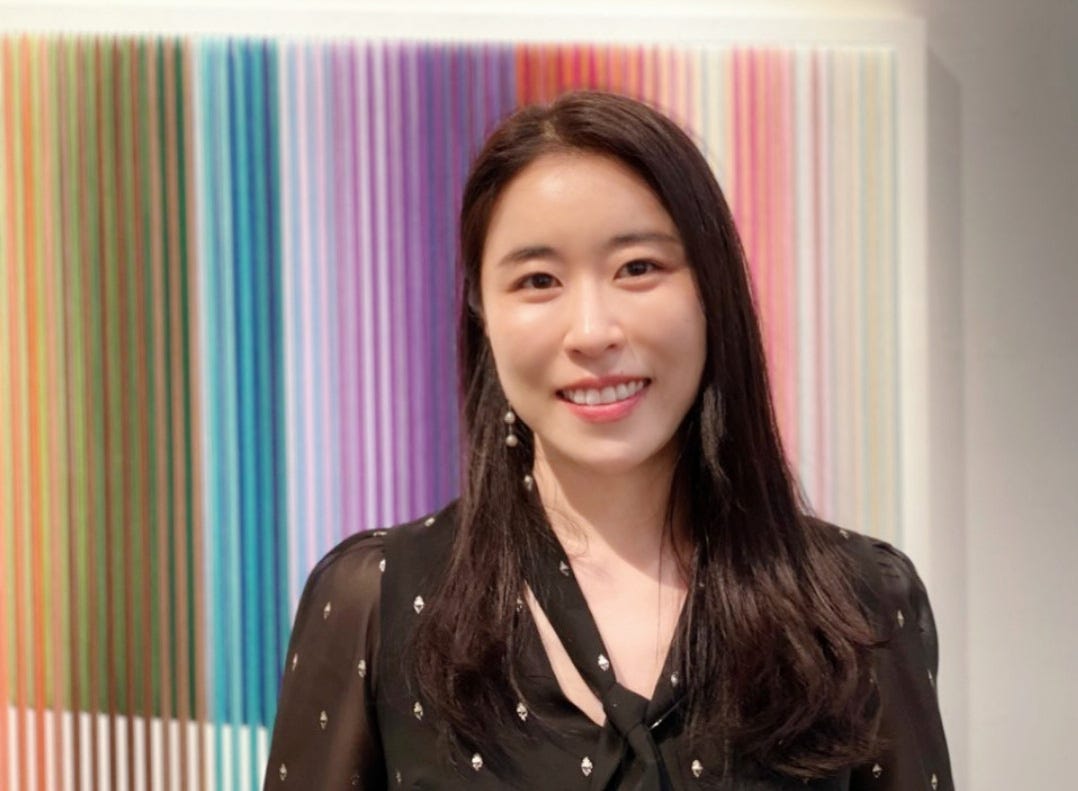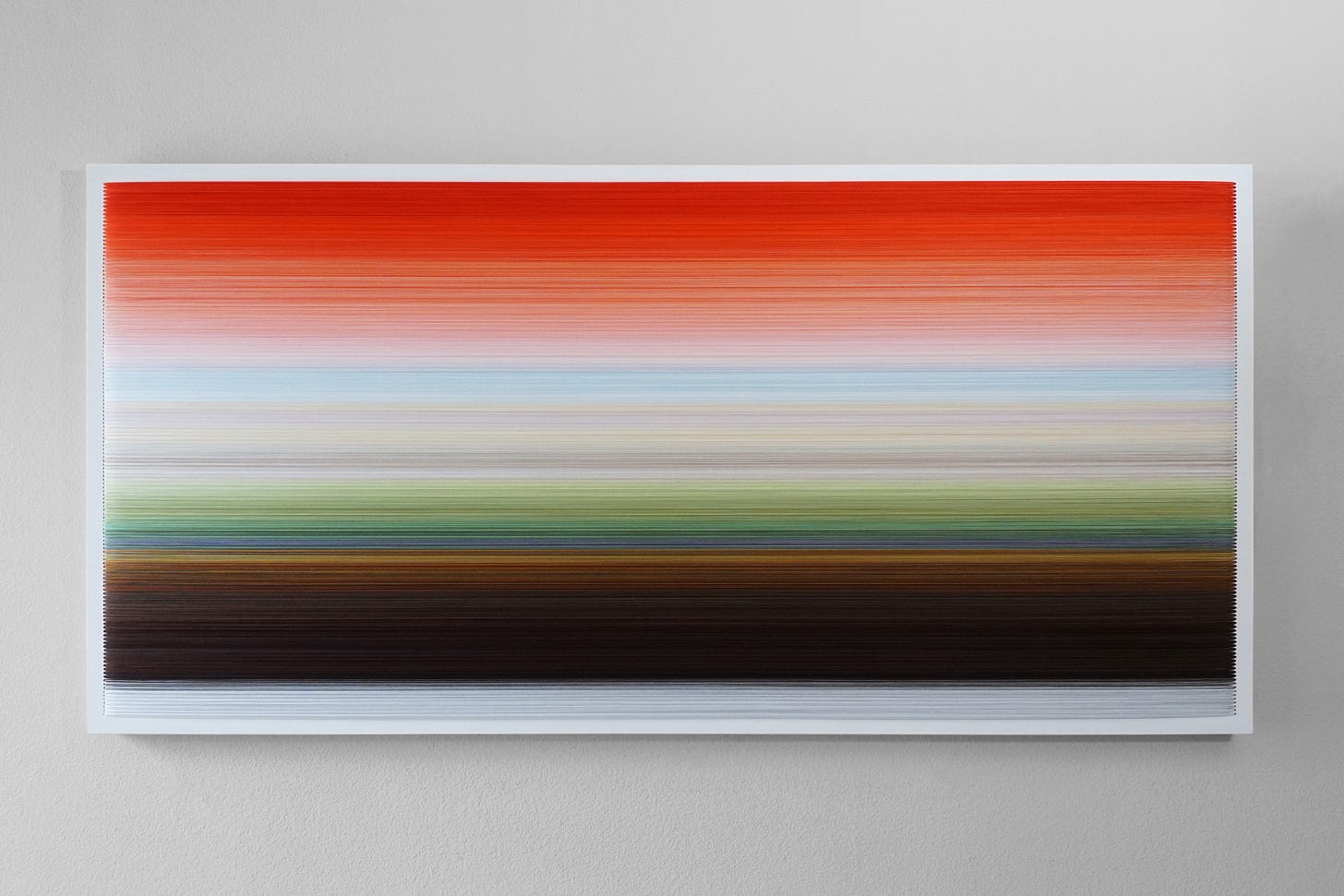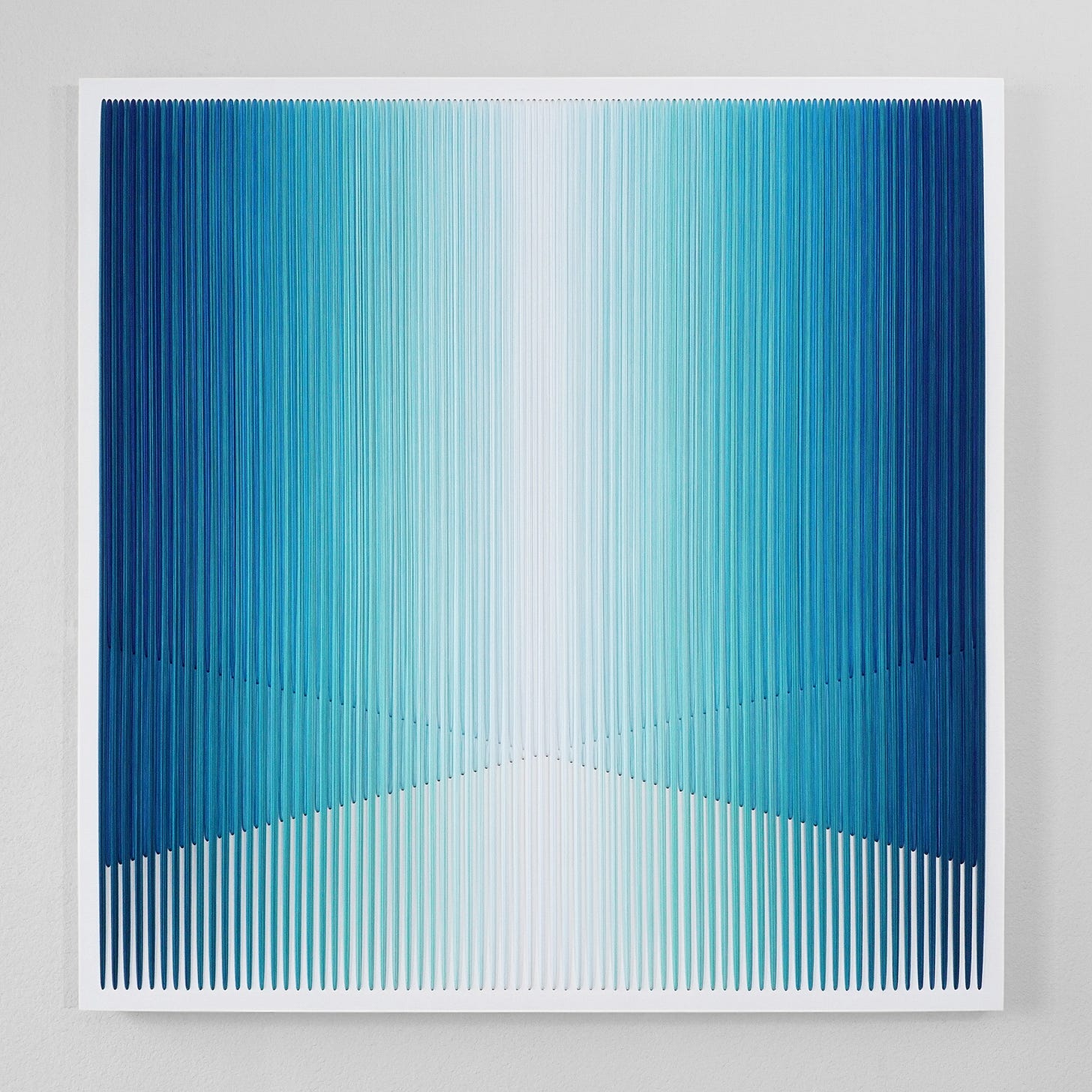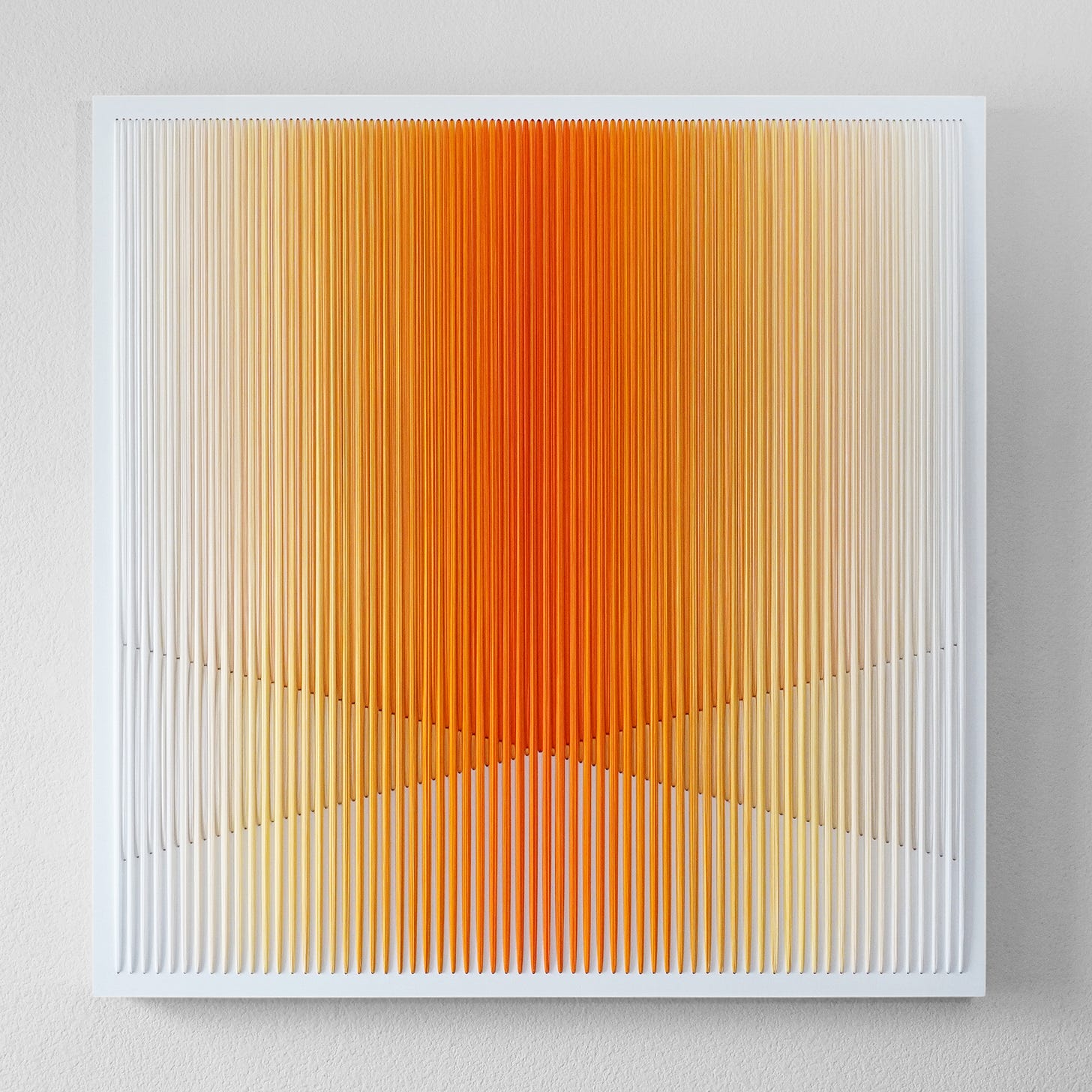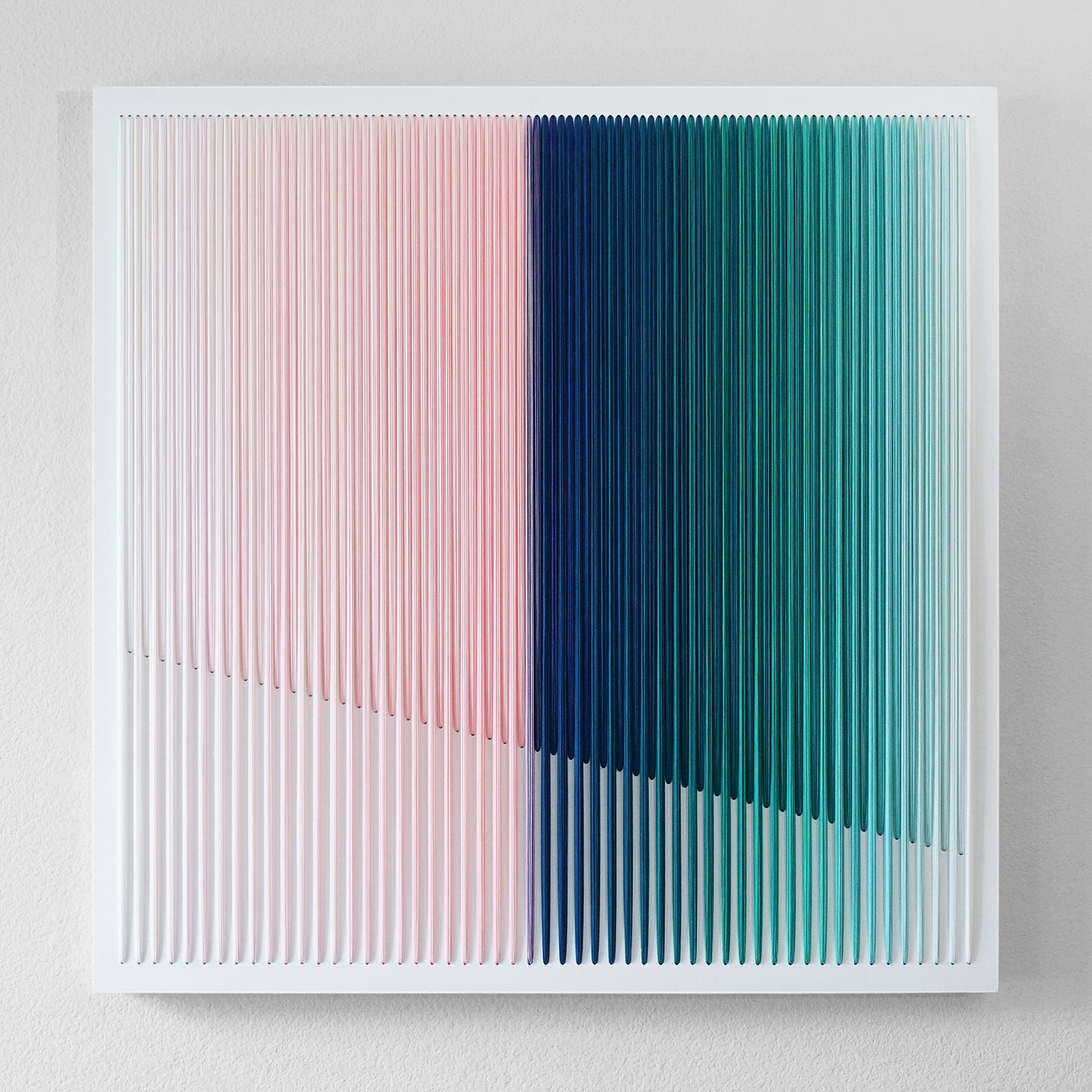Welcome to our first ever post on the Sterling Case! This is the first in our salon series which will feature interviews with artists, creatives, and collectors talking about their work, the art world, and how art fits into their lives.
If you want to see more of this series in your inbox - please subscribe!
Now on to our first interview with Bumin Kim…
About the artist: Bumin Kim was born in South Korea and is currently based in Texas where she received her MFA in Drawing and Painting in 2015 from the University of North Texas in Denton. Kim’s thread-based work acknowledges the transformative power of materiality as she repurposes the context of thread to emphasize and emulate the energy, delicacy, and grace of painting and drawing.
Her work has been shown by various institutions and can be found in public and private collections throughout the United States, South Korea, Japan, and Europe.
Kim’s current exhibition, The Seasons, is on view at SWPK Gallery in New York City through November 23, 2024.
Casey: So, what was your path to becoming an artist? Were you interested in making art when you were a child or did it interest you later?
Bumin: I’ve loved making art since my childhood. Creating art feels so different from studying; I can be more playful and express my ideas without judgment or rules. It’s a truly free experience.
I did an after school program and the teachers were really young and they all majored in art. They would always ask me, “What do you want to do today?” It's not like today's subject is this so you have to do that.
When I was maybe like 10 years old, I always envied the 14- and 15-year-olds and wanted to do what they did. So, I would try and I would just do really bad. But the teacher would say that it's fine and they help me to figure it out. That process was really interesting for me.
Also, my dad studied architecture. When we did school projects, he helped me a lot. I remember a project where we were making a castle with a cardboard box -- like a theater stage. And he tried to make things and then I just kind of learned by watching him. And I asked him, I want to put a queen in that castle, but I don't know how to do it. And then he told me that magazines have girls with a dress, you can pick one of from that. And I picked one, and he cut it, and attached it on a stand.
So, I gathered all these experiences, which allow me to approach art freely.
Casey: Yeah, it sounds like having that freedom of expression as a child, it evokes for me in your work the fact that you're working with thread, right? Because in the ways that you're working with it, it's definitely not how everyone would assume someone who is an artist would work with thread. You're using it as a drawing or as painting and as sculpture.
How did you get inspired to use thread?
Bumin: I really like to use soft material because I can just play with it without any special equipment. But thread is a really interesting material when I think about it. It's really functional in joining two separate entities, like making as one. It just kind of changes everything. It becomes something new.
It used to be a functional material for me, but later on it became like drawing lines or like drawing materials. And with my current series, Landscape, I think that I use it as paint.
Thread is familiar to me because I saw my mom sew a lot when I was a kid. My mom didn't have a job, she took care of the family at home. And when she worked at home, a lot of things involved sewing. So, when I see thread, I think about my mom, and beyond that, my grandmother. My grandmother has this small container, like sewing box, and I would explore what's inside that.
My mom sometimes says that she wanted to pursue certain things but couldn’t because she got married and had kids. She made that decision, but I feel like it would be great if she could, you know, do both. But I really appreciate her for her efforts, care and love. So, when I see thread, I think of my mom, and really, mothers.
Casey: You're also in a way fulfilling what you kind of wish for your mother. You're being able to take this thing that's familiar from your home, from your mom and your grandmother, and make art. It's really great to see those things meld together through your medium.
What do you think textiles could offer artists as a medium in comparison to traditional drawing and painting?
Bumin: I think it's more inclusive because it kind of looks like drawing and can be used as a drawing material. It could be part of a painting or even look like one, but it's still textile, so it crosses those boundaries. It might resemble painting, but with the texture and techniques of textile, it can turn into something else. I can play around in between boundaries.
Casey: Yeah, it goes outside of the borders -- like you can explore a little bit more.
Bumin: I think that it has a lot of possibilities. It is really transformative. You can make installation pieces, you can make sculpture, or two-dimensional work, or you can use it on paper, or on canvas, or just by itself.

Casey:. So your current pieces in the show that just opened at SWPK Gallery, they're really intricate. How arduous are they to make and where does the acrylic come in?
Bumin: The acrylic part is basically the background on the wood panel, which I use like a canvas. I start with some acrylic gesso, then add another layer of acrylic paint. After that, I drill some holes in the wood, and then I thread through the canvas
Casey: So how kind of intricate is it when you're working with the thread? When you're in the threading process making the gradients, what is that process like?
Bumin: It's time consuming. I use colored thread, and if I want a lighter color, it’s similar to painting--I mix in lighter-colored thread. If I want to go darker, I add darker thread. Each strip has approximately 180 to 200 threads.
Casey: Oh, wow.
Bumin: In a way, I think my process looks like stitching. You use holes and you thread between the holes. I wanted a process that doesn't cover the thread or one where I would have to put mediums on the thread because I really like that texture of it. I just did it my own way.
Casey: They're really beautiful. I love the colors and the gradient. Anytime anyone is doing a gradient, I just know how much effort is being put in to create that effect and to make it seamless.
Has the construction of your pieces evolved through the years?
Bumin: Actually, the way I thread the wood panels is quite similar. I've been using thread to create this series for over a decade now. It's strange, though, because after making a significant number of works, I've naturally learned something about the process. I often wonder why I couldn’t realize that earlier, before creating so many pieces.
I get an image in my head, and through the work, I bring it into reality to really see it, to observe every detail, right? Then I think, ‘Oh, I want to improve this part or make that part look different.’ I figure out how to make it happen and give it a try. Some challenges naturally resolve themselves when I take my time.
Finding those moments makes me want to keep working and keep doing. And I just… I keep working on that.
Casey: It almost sounds like a like moving meditation. It's like you're doing these trials and each gets you a step closer to this like perfect image you have in your head, right?
Bumin: Yeah, something like that. It's time consuming. But the technique, well, I got better and better-- feeling more complete with clearer images.
Casey: So for the show at SWPK, the themes of the show are the seasons, evolution, and change. Is that something that's new for you or is that something you've always been interested in exploring in your work?
Bumin: I titled it The Seasons because while I started preparing for the show last year, I was listening to Tchaikovsky's The Seasons quite often. I got this interest in classical music several years ago, and since then I’ve really been inspired by classical music.
When I listened to Tchaikovsky's The Seasons, the body of work is made up of 12 different pieces, and each piece named after a month of the year. I really like the June and October. October, it feels like a little lonely, so that piece is emotional. But for June, I expected a little bit more uplifting, more relaxing. But June, of Tchaikovsky, it is a little deep.
That piece conveys so much emotion. I felt that if I keep this theme of the seasons, which we all have experienced, then maybe my work can invite the viewers to connect with the art on a personal level. Like discovering their own reflections.
I’m also inspired by landscapes, so I think the theme aligns well with my series. I love spending time in nature. It provides full of colors, feelings, and information. And when I see nature, I feel the energy of it. As I’ve gotten older, especially during COVID, I’ve found that nature really helped me expand my perspective on life.
COVID was challenging. Staying home made me feel even more isolated. I would look at pictures of nature that I took and then kind of … I think I relate my feelings to the pictures, I guess.
It brings me comfort to accept that all of life's challenges are simply part of nature and allows me to see them as the beauty of life. Because nature reminds me of the cycles of nature, and going through them is a natural journey.
So, I thought if I reinterpret those inspirations and feelings in my work and create that atmosphere in my art, maybe it can evoke similar feelings or reflections in my viewers.
Casey: Your inspiration…particularly looking at those images during COVID it was very self-reflective. Processing your feelings and realizing they are just part of life and that's all part of the natural experience. And so, yeah, that would hopefully evoke that same process in your viewer.
Bumin: Yeah. It made me think about life. When I’m in nature, I just focus on being human. How to live and how to face death, things like that. So that gives some good insights that helps me navigate this life.
Casey: So after talking about how you hope your viewers see your work… For you as an artist, what would be a dream art exhibition for you to visit?
Bumin: Well, actually, I wanted to go see Richard Tuttle's exhibition in New York, but I couldn't go. I love his work.
But right now, when I think of connecting to the viewers, I think of my experience with Edward Hopper's paintings. He uses light and shadow, which is something I incorporate in my work. But his pieces are more specific since they have figures and recognizable space. I really love how, in his paintings, I can almost guess the time of day. For example, it feels like evening when the sun casts long shadows. And he creates an atmosphere of loneliness that resonates with me. When I see the figures in his work, that sense of loneliness feels familiar, reflecting our own lives. Just feeling connected to the artwork brings me a lot of comfort.
Casey: Kind of a universal experience, right? It’s comforting knowing that other people are have the same experience.
Bumin: Yeah like, “I am not alone”. That emotion feels natural. Hopper’s paintings remind me once again that these feelings are universal, and we all experience them. That’s why I love his paintings, and I want to offer my viewers the same sort of comfort.
You can view more of Bumin Kim’s work on her website on her Instagram @buminkim or visit her exhibition at SWPK Gallery through November 23, 2024.
This interview is edited for brevity and clarity.
For more artist interviews by the Sterling Case, please subscribe to our newsletter and follow us on Instagram @thesterlingcase.





